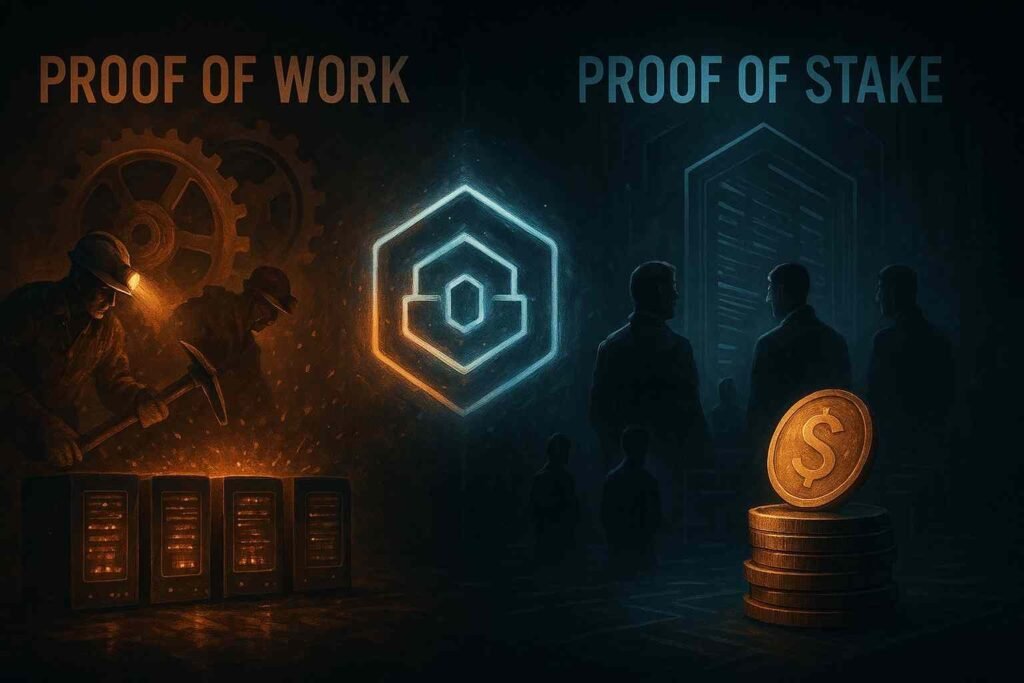
The crypto world loves a good debate, and few topics spark more passionate arguments than the Proof of Work (PoW) versus Proof of Stake (PoS) conversation. After spending nearly seven years deep in the blockchain space, watching projects rise and fall, and yes, losing some money along the way (who hasn’t?), I’ve formed some strong opinions on this topic.
Let me be upfront – I firmly believe PoW remains the more secure consensus mechanism. But I also recognize that both systems have their place in the evolving crypto ecosystem. Let’s dive into why this matters and what you should understand before investing your hard-earned cash in either type of blockchain.
Understanding the Fundamentals: PoW vs PoS
How Proof of Work Actually… Works
Picture this: it’s late 2013, and I’m sitting in my apartment with a custom-built mining rig heating up the entire room. That was my introduction to Proof of Work – Bitcoin’s revolutionary consensus mechanism that forever changed how we think about digital value.
In simple terms, PoW requires miners to solve complex mathematical puzzles by running computational algorithms. The first miner to solve the puzzle gets to add a new block to the blockchain and receives a reward. This process requires significant computational power and, yes, electricity.
The beauty is in its simplicity – miners are incentivized to act honestly because the energy costs of attempting to manipulate the system typically outweigh potential gains from dishonest behavior.
My old mining rig is long gone (sold it during the 2017 bull run – timing wasn’t perfect but could’ve been worse), but the fundamental security model of PoW continues to impress me to this day.
How Proof of Stake Changes the Game
Around 2018, I started closely following the development of PoS systems. The concept seemed elegant: instead of competing through computational work, validators are selected to create new blocks based on the amount of cryptocurrency they’re willing to “stake” as collateral.
If validators attempt to cheat, they lose part or all of their stake. The more you stake, the higher your chances of being selected to validate transactions and earn rewards. No massive electricity consumption, no specialized hardware – just capital locked in the network.
It sounds great in theory. But as my programmer friend Dave likes to say, “In theory, there’s no difference between theory and practice. In practice, there is.”
Why I’m Convinced PoW Offers Superior Security
After witnessing multiple network attacks and security incidents across different blockchains, I’ve become increasingly convinced that PoW provides more robust security guarantees. Here’s why:
1. The Cost of Attack Is Crystal Clear
With Bitcoin’s PoW system, the cost to attack the network is tangible and enormous – you need to acquire and operate more computational power than the rest of the network combined. This isn’t just expensive; it’s also visible and requires physical infrastructure.
Just last winter, I visited a mining facility in Wyoming. The scale was mind-boggling – warehouse after warehouse of specialized ASIC miners, all humming away securing the network. You can’t hide that kind of operation.
PoS attacks, by contrast, can potentially be executed through financial engineering, flash loans, and market manipulation – with less transparent costs and greater potential for unexpected vulnerabilities.
2. Time-Tested Security Record
Bitcoin’s PoW blockchain has maintained security for over 14 years – surviving countless attempted attacks while securing hundreds of billions in value. No other consensus mechanism has been battle-tested for this long under such intense adversarial conditions.
I remember the panic in 2014 when the GHash.io mining pool briefly exceeded 50% of Bitcoin’s hashrate. The community response was swift, with miners voluntarily redistributing hashpower to maintain security. This demonstrated how economic incentives naturally protect the network.
3. The “Nothing at Stake” Problem Isn’t Fully Solved
In early PoS designs, validators could theoretically support multiple competing blockchain histories simultaneously (since it costs them nothing to do so), creating consensus problems.
While newer PoS implementations have developed mechanisms to address this, these solutions introduce additional complexity and potential attack vectors. My background in system architecture has taught me that complexity is the enemy of security – every new feature or fix potentially introduces new vulnerabilities.
4. Stronger Resistance to Centralization Forces
This might sound counterintuitive given the rise of mining pools, but hear me out. In PoW, miners can instantly redirect their computational power if a pool operator behaves maliciously. This happened back in 2013 when the BTCGuild pool approached dangerous hashrate levels, and miners quickly switched.
In PoS, large token holders (often venture capital firms or early investors) have significant validator power from day one. Ethereum’s transition to PoS resulted in a situation where around 30% of validators were controlled by just two centralized staking providers at one point last year – a concentration that makes me deeply uncomfortable.
The Case for Proof of Stake: Being Fair About the Tradeoffs
Despite my security concerns, I recognize that PoS offers genuine advantages:
1. Energy Efficiency Is Significant
No denying it – PoS consumes drastically less energy than PoW. This became painfully obvious when my electricity bill tripled during my brief mining adventure in 2017. For blockchains focusing on high transaction throughput in a climate-conscious world, this is a legitimate consideration.
2. Lower Barriers to Participation
Setting up a validator node is generally more accessible than acquiring and maintaining competitive mining hardware. I spent nearly $12,000 on my last mining setup, while I could stake on several PoS networks for a fraction of that cost.
3. Potential for Higher Transaction Throughput
PoS chains typically offer faster block times and transaction finality. When I transferred assets between exchanges last month, my ETH transaction (post-merge to PoS) confirmed noticeably faster than my BTC transfer.
The Future: Security in a Multi-Chain World
I suspect we’re heading toward a future where both mechanisms coexist, serving different purposes. Bitcoin will likely remain PoW-based, continuing to prioritize security and stability for the world’s premier store of value. Meanwhile, many layer-1 smart contract platforms will use variations of PoS to optimize for throughput and developer experience.
The real innovation might emerge at the intersection – projects that leverage Bitcoin’s security while enabling the functionality of PoS chains. I’ve been particularly interested in rollup technologies that inherit security guarantees from their parent chains while improving scalability.
Making Informed Decisions in Your Blockchain Journey
Whether you’re an investor, developer, or crypto enthusiast, understanding the security tradeoffs between PoW and PoS is essential for navigating this space.
For long-term value storage, I still prefer PoW-secured assets. For active trading and interacting with DeFi applications where transaction costs and speed matter more, PoS platforms make practical sense.
Looking to start your journey in the digital economy? While blockchain technology creates fascinating new possibilities, many people are also finding opportunities in more established online fields. Live Chat Jobs connects qualified individuals with flexible remote positions that allow you to earn while continuing to explore emerging technologies like blockchain.
Final Thoughts: Security as a Spectrum, Not a Binary Choice
After years of observation and participation in this space, I’ve come to view blockchain security as existing on a spectrum rather than as a binary “secure/not secure” proposition.
PoW represents the more conservative, battle-tested approach that prioritizes security above all else. PoS represents a newer paradigm that makes different tradeoffs to address specific limitations.
What matters most is alignment between the consensus mechanism and the blockchain’s purpose. For a network securing billions in value that rarely changes, the conservative security of PoW makes sense. For applications requiring frequent updates and lower transaction costs, PoS might be the better fit.
As you explore opportunities in blockchain and the broader digital economy, remember that understanding these fundamental security models helps you make better decisions about where to invest your time and resources.
Discover flexible online opportunities today while continuing your blockchain education journey.
Remember what my old mining buddy used to say: “In crypto, the only real security comes from understanding what you’re getting into.” Whether that’s PoW, PoS, or any other consensus mechanism, your best protection will always be knowledge.



